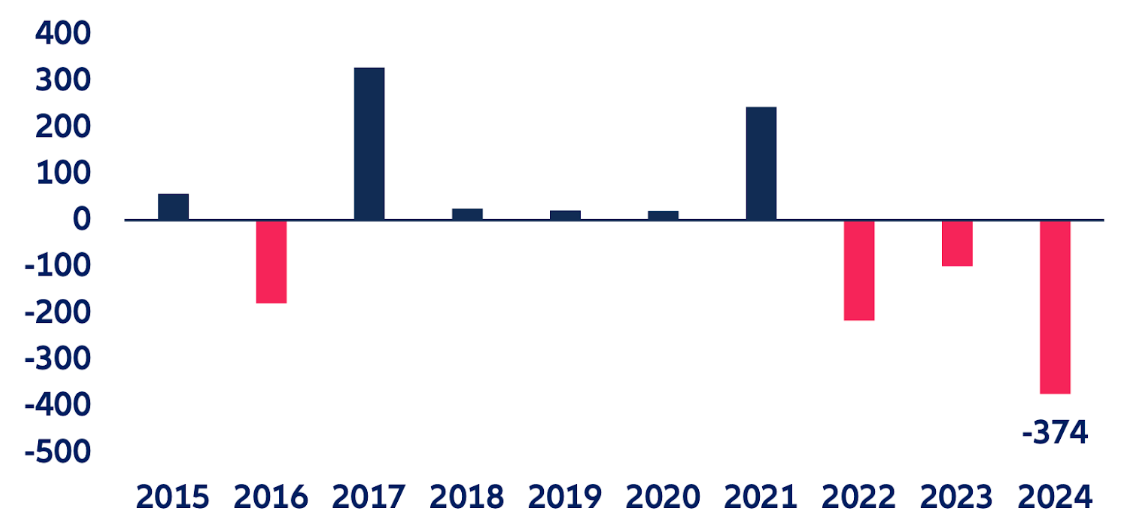
- Cocoa prices soar; shortage from weather, disease impacts
- Record deficit, over-sold futures cause price spikes
- Stabilisation attempts; high prices challenge producers, buyers
The cocoa market is reeling. Failing harvests are sending futures prices vertically upwards, and a solution seems far away. Daredevils looking to get in now are taking the risk of investing in a derailed market.
The price of cocoa on the futures market is rising so fast that editors had to adjust the price four times while writing this article. This week, cocoa futures broke through the 10,000 dollars-per-tonne level. That is 140 per cent higher than at the beginning of this year. A year ago, the price was still below 3,000 dollars.
‘There is no cocoa left’
The supply side of the 45 billion-dollar-plus cocoa market has been hit by what experts call a "perfect storm". An exceptionally wet year in Ivory Coast and Ghana, where some two-thirds of world production comes from, was followed by persistent drought. Under these conditions, the 'cocoa swollen shoot virus' was able to thrive, causing crops to fail for the third year in a row. South American production is also facing problems due to the El Niño weather phenomenon.
 The International Cocoa Organisation estimates the shortfall for this year at a record 374,000 tonnes, with a total production of almost 4.5 million tonnes. "There is simply no cocoa left," said Benoit Harger, commodity portfolio manager at Switzerland's J. Safra Sarasin who previously worked as a cocoa trader at Barry Callebaut, the world's largest chocolate producer.
The International Cocoa Organisation estimates the shortfall for this year at a record 374,000 tonnes, with a total production of almost 4.5 million tonnes. "There is simply no cocoa left," said Benoit Harger, commodity portfolio manager at Switzerland's J. Safra Sarasin who previously worked as a cocoa trader at Barry Callebaut, the world's largest chocolate producer.
Cocoa market deficit (in thousand tons)

In recent weeks, the severe drought in West Africa has exacerbated existing production problems, leading to a further reduction in production expectations for 2024. This situation has been further complicated by Ivory Coast selling too much of their main crop, which is harvested between October and January, on the futures market. Actual production has been significantly lower than anticipated.
‘Short squeeze’
"As a result, numerous physical traders and trading houses are in a predicament, with short futures positions that were meant to be hedges but now without any cocoa being delivered, leading to a short squeeze," said Robert-Jan van der Mark, head of investment quants at Aegon Asset Management.
In such circumstances, the price is further driven up because contract holders cannot meet their delivery obligations.
 According to Ralph Sandelowsky, commodity portfolio manager at Achmea, the challenges have been exacerbated by the significant increase in natural gas prices in 2022. As a result, farmers have been able to invest less in fertilisers and pesticides. Aging trees are also extra susceptible to disease, resulting in disappointing yields.
According to Ralph Sandelowsky, commodity portfolio manager at Achmea, the challenges have been exacerbated by the significant increase in natural gas prices in 2022. As a result, farmers have been able to invest less in fertilisers and pesticides. Aging trees are also extra susceptible to disease, resulting in disappointing yields.
Wisdom Tree Cocoa ETF
Those who benefited from the market turmoil are investors who, for instance, bought WisdomTree's leveraged cocoa ETF two years ago, a fund worth some 20 million dollars. They saw their deposits increase in value by more than 1000 per cent in the last 12 months. Hedge funds trading on the futures market meanwhile seem to have hit their stride.
To discourage further speculation by hedge funds, the futures exchanges have tightened their margin requirements. "Open interest" data shows that there is actually very little trading and very limited liquidity.
 "The futures markets indicate that unfavourable positioning is almost exhausted," said Van der Mark, "and on top of that, weather forecasts show that rain should come to the region, which should ease prices somewhat in the near future."
"The futures markets indicate that unfavourable positioning is almost exhausted," said Van der Mark, "and on top of that, weather forecasts show that rain should come to the region, which should ease prices somewhat in the near future."
See: ‘Commodity rally has much further to go’
The number of contracts outstanding has fallen after peaking at the end of January, and the number of traders betting on a price rise has fallen back this month to its lowest level since 2021, open interest shows. That has fallen 35 per cent in the past three months, the biggest drop in such a short period in at least three decades.
 Rotterdam-based hedge fund Transtrend, which earned much of its turnover from "long" cocoa positions this year, has cut most of its exposure to futures contracts. Marc van Loo, responsible for Investor Relations, said he expects most hedge funds to reduce their exposure as the price rises in a vertical line, as this increases the risk of a price fall.
Rotterdam-based hedge fund Transtrend, which earned much of its turnover from "long" cocoa positions this year, has cut most of its exposure to futures contracts. Marc van Loo, responsible for Investor Relations, said he expects most hedge funds to reduce their exposure as the price rises in a vertical line, as this increases the risk of a price fall.
Problem for physical trading
For now, the decline in open interest is not yet matched by a drop in prices, which is an indication that the market no longer operates according to the normal mechanism of supply and demand. It is the buyers of the physical beans such as chocolate producers and traders of cocoa that are fuelling the recent price rise. Accepting insane prices is a bitter necessity for many, and that hurts the trade.
Commodity portfolio manager Harger of Safra Sarasin, describes the cocoa trading community as a "passionate and emotionally involved" one. "The market is really facing a supply problem. Suppliers are facing problems. Some traders are just unable to pay the price," Harger said.
‘Demand destruction’ needed
In the cocoa market, buyers often take short positions as a hedge against potential price drops. This strategy requires traders to maintain a cash reserve proportional to their futures contracts' underlying value. However, an unexpected price increase forces those with short positions to face margin calls, pushing many towards liquidation due to insufficient funds, further exacerbating the price hike.
 Gerard Stapleton of GlobalData and Harger highlight a need for "demand destruction" to stabilize prices. The lingering question, according to Stapleton, is the duration until market rebalance and whether supply can rebound in the interim.
Gerard Stapleton of GlobalData and Harger highlight a need for "demand destruction" to stabilize prices. The lingering question, according to Stapleton, is the duration until market rebalance and whether supply can rebound in the interim.
Despite these market challenges, the profitability outlook for chocolate producers remains positive, with Allianz predicting a one per cent average increase in earnings per share for major listed chocolate companies. To safeguard their profit margins, producers might reduce cocoa usage, substitute it with cheaper alternatives, or reduce product sizes. Alternatively, raising prices is another viable strategy, as demonstrated by Lindt & Sprüngli, Tony's Chocolonely, Mondelez, Ferrero, and Neuhaus, who have all reported significant price hikes. Overall, consumer prices are up a mere 12 per cent in the last year, said Harger.
 Allianz's chief economist Ludovic Subran said that to alleviate market pressures, higher consumer prices need to filter down to West African cocoa farmers to incentivize enhanced production. Yet, the retail price increases still lag behind the surge in cocoa prices, indicating that chocolate consumers have yet to bear the full brunt of the market's volatility.
Allianz's chief economist Ludovic Subran said that to alleviate market pressures, higher consumer prices need to filter down to West African cocoa farmers to incentivize enhanced production. Yet, the retail price increases still lag behind the surge in cocoa prices, indicating that chocolate consumers have yet to bear the full brunt of the market's volatility.
Video: Fighting the Cocoa Swollen Shoot Virus in Ghana:
Further reading on Investment Officer Luxembourg:
- ‘Commodity rally has much further to go’
- Goldman forecasts 43% return on commodities
- Investors tread cautiously in considering El Niño risks




